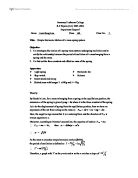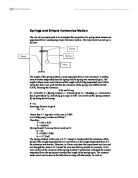However, as the mass of the spring will affect T. T should be equal to where me is the effective mass of the spring.
From the graph, we can obtain the value of force constant k as k = Nm-1 and the effective mass of the spring as it is the intercept on the m-axis.
Procedure:
A. Setting up the mass-spring system
- The light spring was hung from the horizontal bar. The horizontal bar was then firmly clamped on a retort stand.
- The 20g slotted mass was suspended at the other end of the spring.
- After setting up the above apparatus, the oscillation of the mass was started.
B. Oscillation of a mass hanging from the spring
- The first method we have made was that the time was measured at the moment that the weight hanger was attached to the spring. Then, the mass oscillated freely.
- The time for 20 complete oscillations was measured with a stop-watch. Two to three trials were performed. The timing was then repeated twice. The results were recorded to find out the mean time and the period of oscillation of the mass.
- During the oscillation, the following points were observed:
a). motion of the mass was needed to be vertically upwards and then downwards
b). the oscillation was needed to be at a steady rate
- The experiment was repeated several times using different masses suspended at the end of the spring by attaching the weight hangers to the spring.
-
The second method was that the weight hangers were first attached to the spring until the equilibrium position is reached, then the spring-mass system was set into vertical vibration with an amplitude of no more than 5 cm.
- Steps 2 to 4 were repeated.
- At the end of the experiment, the spring was removed and the mass of it was obtained using a balance.
Results:
(a) Tabular form
(b) Graphical form
Slope of the graph = =1.82, k = = 21.7Nm-1
The equation of the trend line is y = 1.8267x + 0.005,
for y = 0 ,x-intercept = -0.00274 kg, ∴ the effective mass of the spring is 0.00274kg
mass of the spring = 5.2g
Conclusion:
From the graph “The relationship between the (period)2 and the mass”, the value of T2 and m are proportional to each other with the slope equals to where k is the force constant of the spring.
According to step 5 in the procedure, the amplitude does not affect the period of oscillation, so T is independent of the amplitude of oscillation, Hooke’s Law is obeyed. ∴. As the force constant of the spring is a constant, the only varibles are T and m. As a result, the period of oscillation varies with the mass and we can obtain the force constant by finding out the slope of the graph. The result obtained is that the force constant is equal to 21.7 Nm-1.
Furthermore, the effective mass of the spring is 0.00274kg. Besides the mass m, the effective mass of the spring also affects the period of oscillation. When the effective mass is zero, the graph will pass through the origin. As a result, the x-intercept gives the value of the effective mass of the spring.
It is necessary to point out there is limitation of the conclusion since the measurement was carried out for mass in the range from 0.02kg to 0.24kg only. The relationship (i.e. k = ) holds in this range of mass, and it is suggested to have further investigation for more accurate result and to show that if the relationship still holds outside this range of mass.
Discussion:
-
The graph does not pass through the origin owing to the mass of the spring and the movements of its various parts. Besides the mass m, the effective mass of the spring also affects the period of oscillation T. If the effective mass me is neglected, the straight line will pass through the origin. Therefore, the intercept on the m-axis gives the effective mass of the spring. It is shown as below:
T2 = 4π2
∴
When T = 0, m = -me
- Theoretical consideration of the kinetic energy of the vibrating spring shows that the effective mass is equal to one third of the actual mass. This is correct although the mass of spring does not equal to three times of the effective mass. The results didn’t show this because there were many errors.
Mass of spring = 0.0052 kg
Effective mass of spring = -(x-intercept) = 0.00274kg 1/3 × 0.0052kg
Percentage error = % = 58.1%
- Errors existed during the experiment which causes deviation of the results:
- Random errors arised because of reaction times of the timekeeper, which is about 0.02s for a normal person.
- Reading errors arised when weighing the mass of the spring. The maximum possible error will be ± 0.01g.
- Errors arised when counting the number of oscillation of the mass.
(i) When the mass used is very small, just about 20g, T is very short that the oscillation occurs at a very fast rate, for about 20 oscillations within a few seconds. It is very difficult to observe one oscillation by the human eyes. As a result, errors exist.
(ii) When the mass used is very great, about 240g, T is long enough for observation. However, as the value of the effective mass is very small, the large value obtained for T2 and m will result in a great deviation of the value of the effective mass.
- Modification of the experiment:
Use a more accurate balance or an electronic balance instead.
Reference:
-
Demontration of the experiment ( a video )
2. Details of the experiment
3. Theory is based on Raymond W.N. Chan’s Physics Beyond 2000 ( 2nd Ed.) P. 77-78
-
Tao, Lee & Mak’s A-Level Practical Physics (2nd Ed.) P.35, 36







